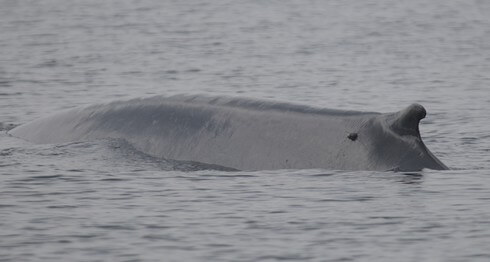Update – January 20, 2016: Return to Northern Waters and Media Coverage of the Project!
According to the most recent data, the blue whale B197 has circled back and is heading north again. They’re also talking about the project and the months-long monitoring of the blue whale Symphonie that was conducted last winter.
- Sur les traces de la grande bleue (Le Devoir, Alexandre Shields, January 7, 2016; in French)
- Suivre la migration d’une baleine bleue en vue de protéger l’espèce (Radio-Canada, January 2, 2016; in French)
And to learn about the latest developments regarding the whales that have been tracked since last fall, check out the maps on the Mingan Island Cetacean Study’s (MICS) Facebook page.
November 5, 2015: Two additional tags were placed this week on blue whales.
Moreover, one of them is on Crinckle, a unique individual easily recognizable by its wrinkled skin. Both animals were then seen off Betsiamites in the North Shore region on November 3.
October 26, 2015: This autumn in the Estuary, two Argos satellite tags were placed on the backs of blue whales. “One of the two tags, placed on a male known to the MICS team, is still transmitting data and shows that the animal spent some time north of the Magdalen Islands before moving out into the Cabot Strait”, points out researcher Véronique Lesage of Fisheries and Oceans Canada (DFO), who is steering the project. To follow this giant on its journey, maps are available on MICS’ Facebook page (October 28). Where will he go next? Blue whales spend time in the rich waters of the St. Lawrence to feed and replenish their energy reserves. Migrating in the fall allows them to reach more temperate waters, where they likely breed, but these seasonal movements and wintering areas are still poorly understood.
Indeed, the satellite tracking program aims to fill this very knowledge gap on those areas that are intensively used by blue whales and that make up the critical habitat of this population. “The Canadian Species at Risk Act requires that critical blue whale habitat be identified and protected. However, in 2012, it was concluded that existing data were too incomplete to make any designation in this regard. This led to another legal obligation of the DFO, which is to conduct the necessary studies in an effort to make a minimum designation, five years later, of critical habitat (p.33). It is within this context that the present study falls, as do further studies conducted by other DFO scientists from the three Atlantic regions (Newfoundland and Labrador, the Maritimes and Quebec),” emphasizes Dr. Lesage.
This study, spearheaded by the DFO and carried out in collaboration with the MICS team and researcher Russ Andrews of the Alaska SeaLife Center, is in its fifth year. Since 2010, 20 telemetric trackings have been conducted. Last winter, the blue whale Symphony was tracked for more than five months across the Atlantic. Considering the difficulty in keeping these tags attached for long periods (tracking durations generally vary from several days to 70 days), this was a new record. Symphony was also seen again this fall in the Estuary. Véronique Lesage hopes to repeat the same success that was enjoyed with Symphony. Perhaps tracking this male will reveal other wintering grounds different from those frequented by Symphony.
A review of all data relevant to the designation of critical habitat, including new results obtained by the DFO in the past 5 years, is planned for next February in Vancouver. These results will be communicated to the blue whale recovery team – consisting of experts from different backgrounds – who will make a recommendation to the Department of Fisheries and Oceans, which can then assess this information and make at least a minimal designation of critical blue whale habitat to be protected.
To learn more:
On the Fisheries and Oceans Canada website:
On the Mingan Island Cetacean Study (MICS) site:
On Whales Online:





